Mushrooms are considered to be nutritionally healthy and a scrumptious food by the maximum population residing throughout the globe. It is evident from the past literatures that the aroma of these attractive looking macro-organisms was utilised to allure the aristocratic Romans. Moreover, many forms of these macro-organisms had been considered as a fantastic subject for photography by the photographers [1]. Since ancient times mushrooms have been an important part of the human diet. It was even considered as “Food of the God” by the Romans. Mushrooms were believed to provide strength during the battle by the Greek and according to Chinese, it was considered as a health food or “Elixir of Life” [2]. By definition, a nutraceutical is a part of a food substance or whole food having medical or health benefits such as treatment or prevention of disease. Mushrooms due to its diverse chemical complexity act as an untapped reservoir of new drug formulation and as a nutraceutical source [3].
Materials and Methods
Varied high impact peer-reviewed articles have been considered for the comprehensive systematic literature review. The below mentioned sequential strategy have been adopted for composing this review article.
Selection of Articles and Research Philosophy Involved
Search Strategy
From the existing scientific databases, the varied primary and secondary research articles were reviewed by the doctoral fellow (first author) followed by the other two authors independently based on the framed inclusion and exclusion criteria, depending mainly on the focused research topic. The suitable electronic databases sources that were reviewed were Google Scholar, PubMed, PsycINFO, Medline, and Grey literature databases namely GreyNet International, Open Grey, and Med Nar. The literatures were screened by customising the databases based on the pre-determined inclusion and exclusion criteria and up to the most recent contents of the year, 2019. Only full-length articles were considered for the review of the articles and any articles whose abstract and the topic was not matching with the focused research title was not considered for the review purpose. Moreover, any pieces of literature which were not communicated in dialect English were not considered for the systematic review purpose. For the present study, the research philosophy used was Positivism as this philosophy of the research is considered to be appropriate for the elucidation of research findings that have been acquired from the authenticated origin and therefore, allows the researchers to develop an analytical frame of mind to investigate critically about the concerned research topic. Authors have used the Medical Subject Heading (MeSH) search approach along with the truncated search strategies and keywords to get trustworthy findings. The utilisation of the Boolean operators, ‘AND’, ‘OR’ had been used to narrow down the inquiries from the extensive range of information existing on the scientific databases. The keywords that have been used for the systematic review are: mushrooms, nutraceuticals, healthy diet, health benefits. Inclusion and exclusion criteria is shown in [Table/Fig-1].
Inclusion and exclusion criteria for selection of articles.
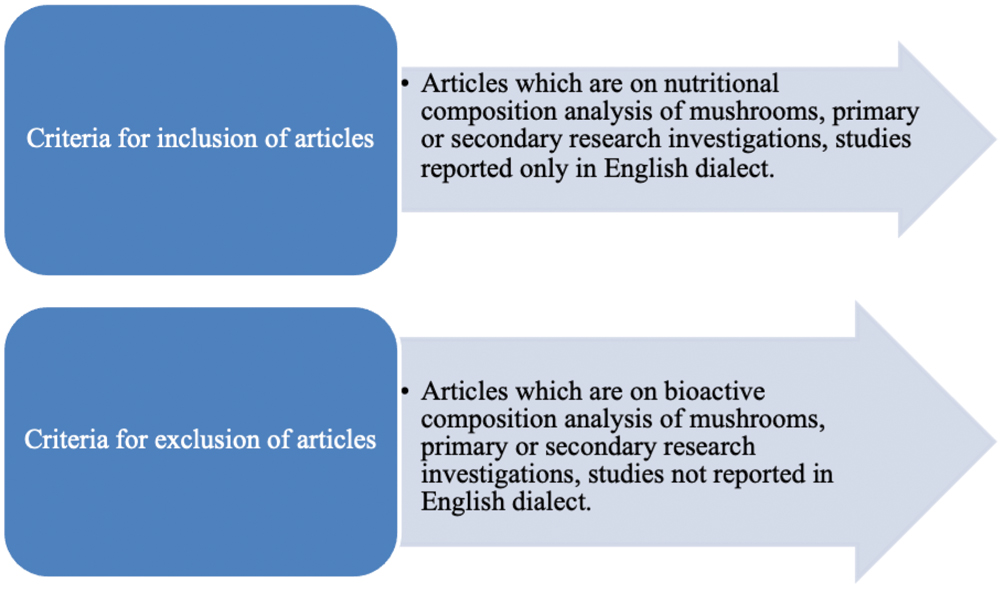
Screening of Evidences and Data Extraction
Scientific pieces of evidence that were found to be duplicated with regard to their compositional contents were recognised and were not considered for the review purpose and they were screened stringently depending on the pre-determined criteria of inclusion and exclusion as decided by all the authors of the present article. The detailed screening or selections of articles were described via the PRISMA Diagram [Table/Fig-2]. Authors extracted the findings autonomously based on the following parameters: study designs; types of mushrooms utilised; nutritional content analysis; health outcomes following the consumption of the mushrooms. The risk of bias was measured for the articles based on the methodological design of the scientific pieces of evidences. The following risk of biases that were ruled out for the comprehension of systemic review were- the review of the articles were carried out independently by all the individual authors based on the set inclusion and exclusion criteria. Another important aspect considered for the removal of bias was following of the sequential steps of the PRISMA-P protocol for the synthesis of systemic literature review. The “evidence selection bias” or the “publication bias” was also taken into consideration by following the checklist of Critical Appraisal Skills Programme (CASP) analysis.
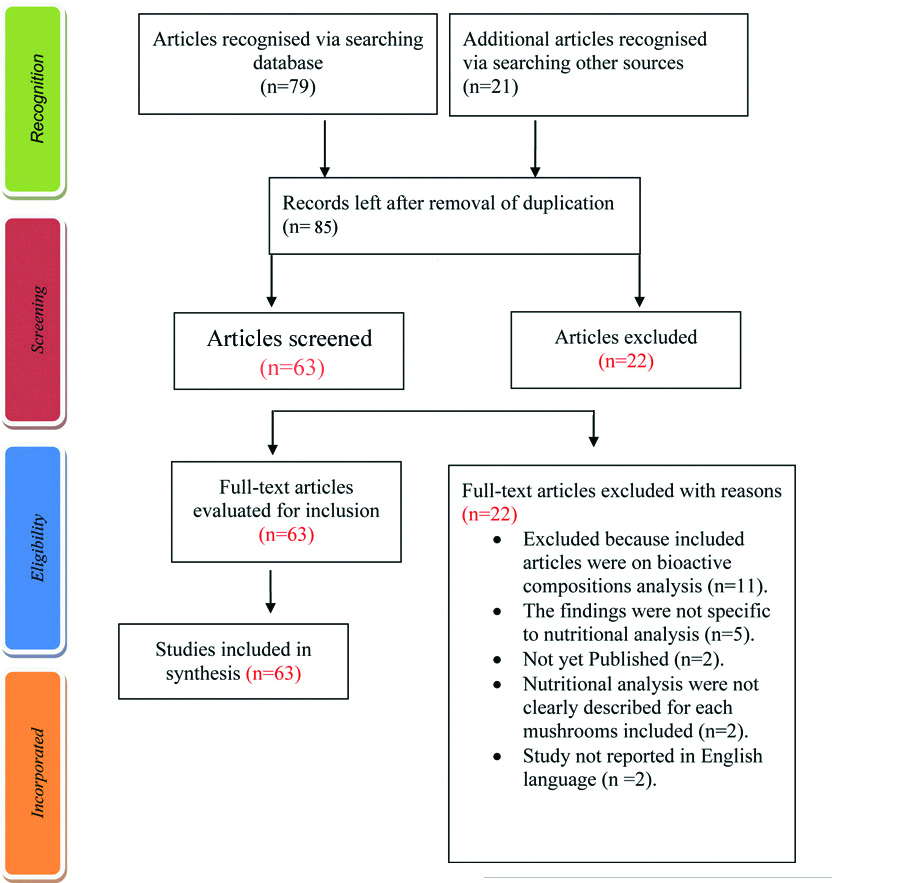
Results and Discussion
The findings of the selected pieces of evidence were critically appraised and presented under the following sub-headings or themes:
Classification of Mushrooms based on Shape and Structure
(a) Morels or Sponge Mushrooms
The characteristic feature of morels is that the cap has irregular pits or ridges. The height of the plant is 2-6 inches. The colour of the cap is tan to brown whereas the stem is somewhat pale. The texture of both stem and cap is brittle. Morels can be of great pleasure when cooked and also can be dried easily for future use [Table/Fig-3] [4].
Morchella esculenta, a yellow morel, edible in nature [4].
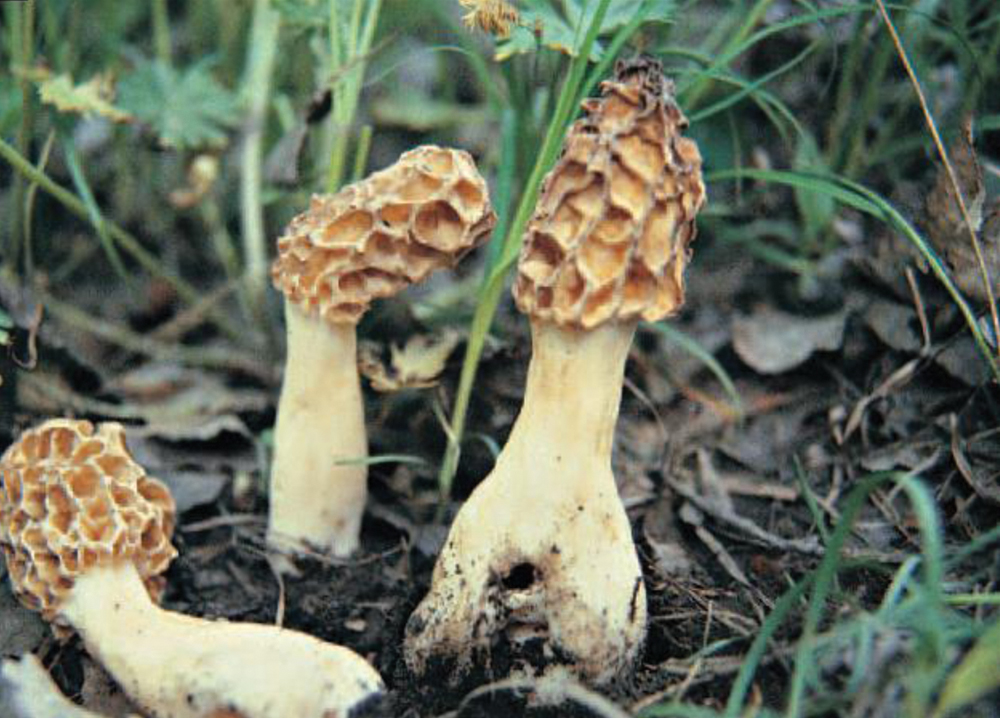
(b) Puffballs
Usually grows on the ground or rotten wood or logs. They are mostly spherical with a round head and a narrower base, whitish in colour. The interior of the ball is firm and white. It is generally found in open parks, grassy meadows, and among the hardwood trees and bush. If the interior of the puffball turns yellow then those are not desirable as food [Table/Fig-4] [5].
Bovista plumbea, a common edible puffball mushroom [5]
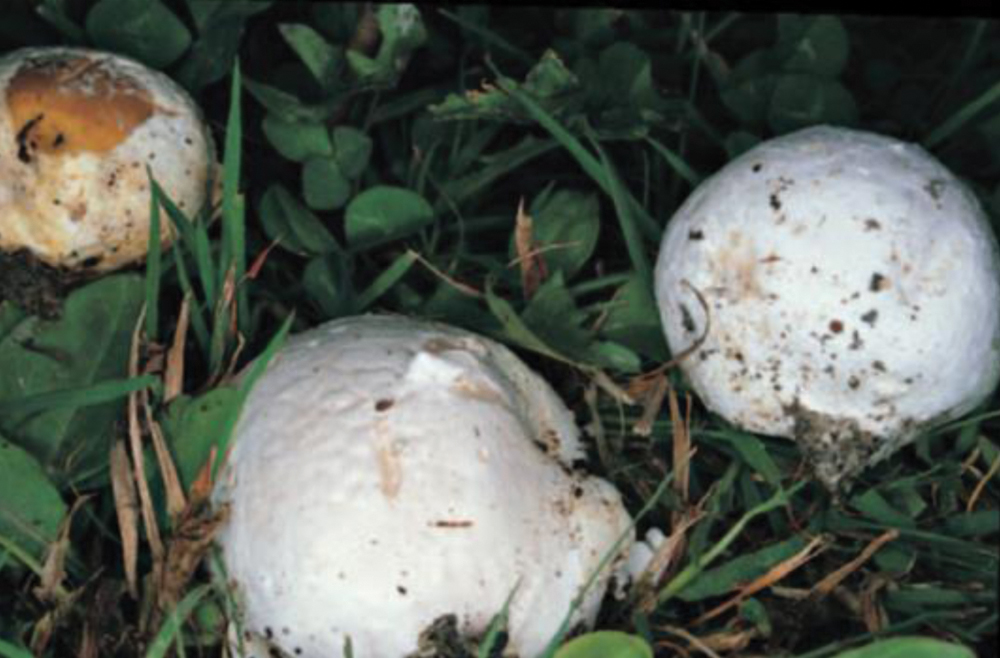
(c) Sulphur Shelf Mushrooms or Sulphur Polypores
These mushrooms grow on old rotten logs and on standing trees which may be dead or living especially on oak trees. The sulfur polypores appear as colourful orange and yellow rosettes of fan-shaped shelves. Freshly collected samples have upper surface zoned with yellow and bright golden orange and the lower surface is bright yellow in colour. Exposure to weather changes the colour of the upper surface to pale yellow. The lower surface consists of a layer of fine pores due to which the name is polypore. Once cooked it is served as a delicious meal [Table/Fig-5] [4].
Sulphur self on a rotten log [4].
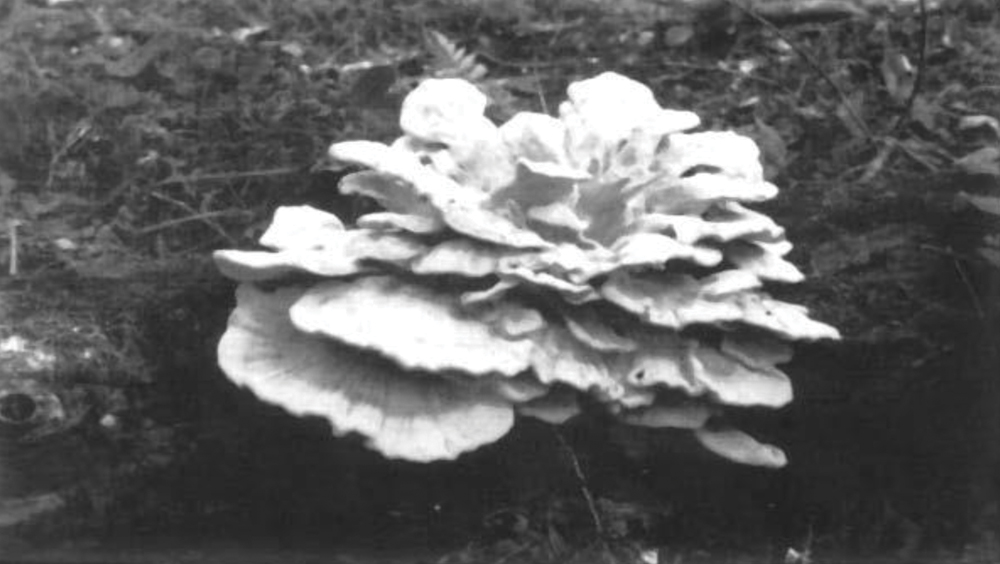
(d) Shaggymanes
These are edible mushrooms and the characteristic features of this mushroom are the dissolution of the ripened cap into black liquid. This particular group of mushrooms is generally 4-6 inches high. The cap is almost cylindrical, white in colour, shaggy, and has a brownish pointed tuft. Young samples have a narrow loose ring around the stem at the lower edge of the cap but it soon disappears at that time. Generally, shaggymanes grow on grassy fields or parks and they appear at the same place every year. They cannot be stored for more than a few hours [Table/Fig-6] [4].
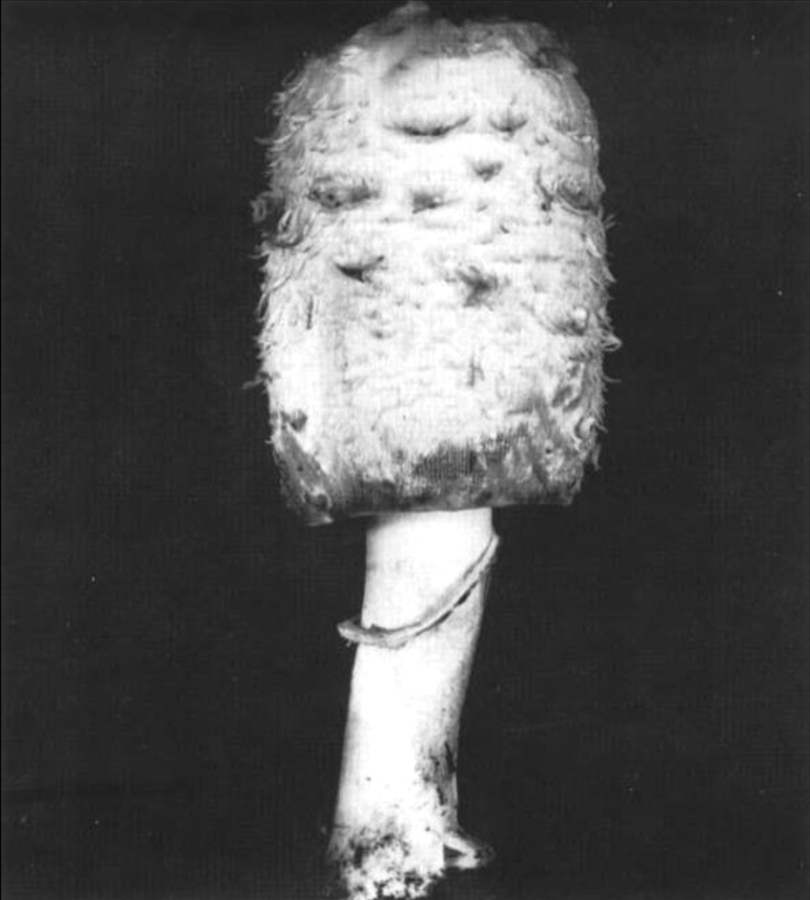
(e) Gilled mushrooms
Oyster mushroom (Genus Pleurotus)
The cap of these mushrooms is more like an oyster in shape and therefore, they are known as oyster mushrooms. It usually grows in clumps, it may be 3-6 inches wide, the upper surface is white or ivory coloured, and is smooth in texture. It is fleshy, soft, and spongy. An unwanted feature of this particular mushroom is that it decays rapidly. They generally grow on dead woods or logs specifically in autumn. The spores can be of various colour lilac, grey, or white.
Several species of this genus are widely cultivated and they can be of varied colours like grey, pink, white, yellow. Several edible species belong to this group like P. ostreatus, P. sapidus, P. ulmarius, P. florida, P. sajor-caju etc., [Table/Fig-7,8] [4].
The well-known edible oyster mushroom Pleurotus ostreatus [5].
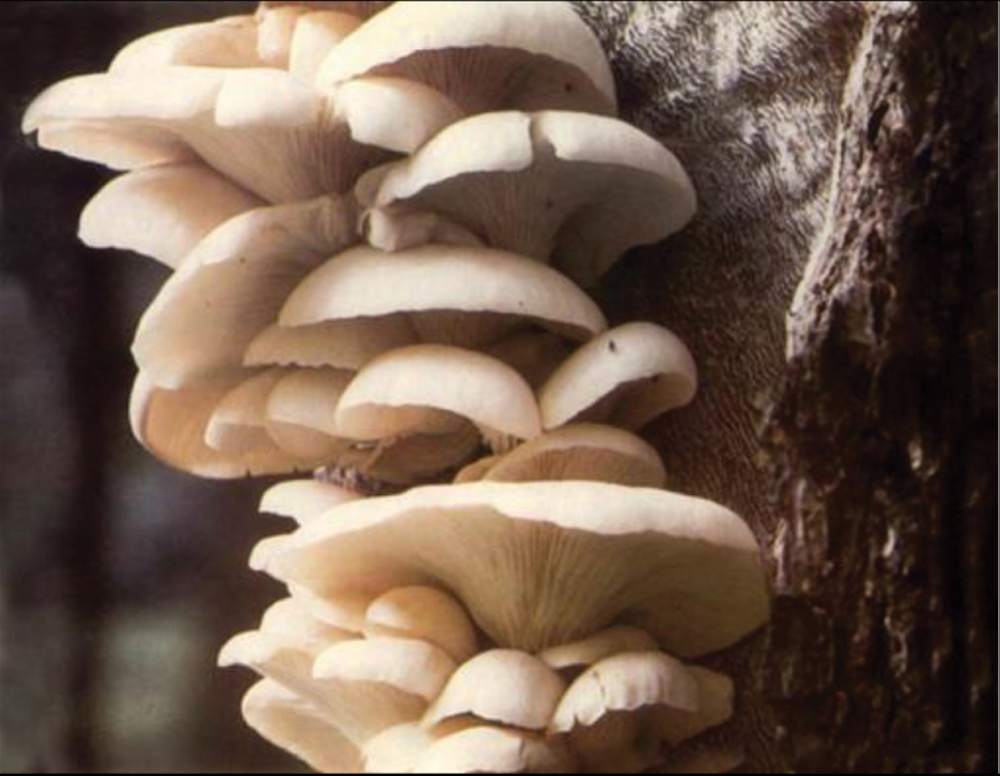
Some common edible mushrooms (a) Pleurotus florida; (b) Pleurotus sajor-caju; (c) Pleurotus eous

Conditions requirement for cultivation of these mushrooms:
The oyster mushrooms are easy to grow if some factors are considered carefully such as: strain selection, optimal substrate and climatic conditions, and prevention of pests. It can be cultivated on freshly cut log stumps in the forests [4].
(f) Tropical Milky White Mushroom
Calocybe indica
Calocybe indica is the first milky white mushroom variety rediscovered from Tamil Nadu Agricultural University, Coimbatore, India during 1998 [6]. The growing season of this particular mushroom is between May and August, a season with sufficient shower after a long dry spell. The species is saprophytic in nature and sometimes ectomycorrhizal with roots of plants like Cocos nucifera, Borassus flabellifer, Tamarindus indicus and Peltophorum ferruginum [6].
Around 2000 species exists in nature among which 25 are widely accepted as edible in nature and only few of them are cultivated commercially. The most cultivated variety worldwide are Lentinula edodes, Flammulina velutipes, Agaricus bisporus, Pleurotus spp., and Calocybe indica. The production of mushrooms is increasing day by day. China is the largest producer in the world [7-10]. They serve as a great nutritional source as they are rich in proteins, contains essential amino acids, fibre, and an excellent source of fatty acids but poor in fat content. Their nutritional significance increases due to the presence of vitamins B1, B2, B12, C, D, and E [11,12]. Interestingly, mushrooms contain vitamin D, and therefore they are the only natural vitamin D source for vegetarians. Unlike cultivated mushrooms, wild mushrooms are an excellent source of vitamin D2, as cultivated mushrooms are generally grown in the dark and UV-B light is needed to produce vitamin D2. They also contain various bioactive components such as terpenes, steroids, anthraquinones, benzoic acid, and quinolones [2]. Therefore the common saying is appropriate for mushrooms, i.e., “medicines and food have a common origin” [12].
The significant content of carbohydrate is available in edible mushrooms in the form of chitin, glycogen, trehalose, and mannitol. They also contain fibre, β-glucans, hemicelluloses, and pectin substances. Glucose, trehalose, and mannitol are among the abundant sugars present in the cultivated edible mushrooms but fructose and sucrose are found in low amounts [2].
Nutritional Analyses
1. Carbohydrates
Mushrooms have a significant concentration of complex polysaccharides and they are pharmacologically very important due to their antitumour and immunomodulating properties. The common carbohydrates of various mushrooms showing important biological activities are: xylose, rhamnose, fucose, fructose, glucose, mannose, mannitol, sucrose, maltose, and trehalose [13-16]. The polysaccharides of mushrooms showing antitumour activity are acidic or neutral and they differ in their chemical structure significantly. Glycans such as homopolymers or extremely complex heteropolymers show antitumour activity. Mushroom polysaccharides modulate the immune response of the host by activating it and they do not kill the tumour cells directly. These compounds lower the stress on the human body and show a reduction in tumour size by about 50%, thereby increasing the survival time of the tumour bearing in mice [17,18].
Oyster mushroom such as Pleurotus mushroom is definitely a good source of carbohydrates and dietary fibres. Chitin, α- and β-glucans, and other hemicelluloses (for example mannans, xylans, and galactans) are the most abundant polysaccharides present in mushroom [19]. A specific glucan named pleuran, shows antitumour properties and it is present in Pleurotus sp. The content of polysaccharides and dietary fibre ranges from 36 to 60 g/100 g dry fruit bodies and 10 to 31 g per 100 g dry weight, respectively and it varies from species to species [20-24]. The mushroom’s cell wall is mostly composed of β-glucans and this component is very useful for industrial purposes as they get excreted in the cell growth medium which allows their easier recovery, purification and characterisation chemically [24-26]. This particular component is responsible for anticholesterolemic, antioxidant, immunomodulating, and also neuroprotective activities. They bind to membrane receptors and initiates biological responses such as stimulating the immune system [27-30]. β-glucans are considered by our immune system as “self-molecules” and therefore can induce both innate and adaptive immune response [31]. Hence they protect human beings from any infectious diseases and also help in recovery from chemotherapy and radiotherapy. Their concentration ranges from 0.21 to 0.53 g/100 g dry basis [32,33], though changing ability can be seen in mushroom species [Table/Fig-9].
Approximate composition of macronutrients of some important edible mushrooms: (dry weight/weight) g/kg.
| Mushroom spp. | Proteins | Carbohydrates | Lipids | Fibres | Minerals | Moisture | Ash |
|---|
| Pleurotus ostreatus | 17-42 | 37-48 | 0.5-5 | 24-31 | 4-10 | 85-87 | 5.7 |
| Pleurotus sajor-caju | 16-38 | 37-40 | 1-5 | 22-31 | 5-9 | 85-87 | 6.3 |
| Pleurotus florida | 15-21 | 40-43 | 1-5 | 23-27 | 8-12 | 87-88 | - |
| Pleurotus cystidiosus | 17-18 | 43-45 | 5-6 | 25-26 | 7-8 | 86-87 | - |
| Pleurotus highking 51 | 20-21 | 36-37 | 5-6 | 30-31 | 5-6 | 85-86 | - |
| Pleurotus eryngii | 11-12 | 39-40 | 7-8 | 28-29 | 4-5 | 85-90 | 6.2 |
| Pleurotus tuber-regium | 13-17 | 53-54 | 0.2-2 | 15-16 | 4-10 | 88-89 | - |
| Pleurotus flabellatus | 21-22 | 59-60 | 1-2 | 10-12 | 6-7 | 91-94 | - |
| Pleurotus giganteus | 17.7 | 78.0 | 4.3 | - | - | - | - |
| Pleurotus geestaranus | 19-20 | 45-46 | 3-4 | 26-27 | 5-6 | 85-86 | - |
| Agaricus bisporus | 14.1 | 74 | 2.2 | - | - | - | 9.7 |
| Agaricus blazei(dry powder formulations) | 31.3 | 59.4 | 1.8 | - | - | - | 7.5 |
| Lentinula edodes | 4.5 | 87.1 | 1.73 | - | - | - | 6.7 |
(Adapted from [2-12])
a. Polysaccharides from G. lucidum
Ganopoly, the polysaccharides from G. lucidum are available commercially in several Asian countries. It is the polysaccharide fraction isolated from the fruiting bodies of this mushroom [34]. Ganopoly administration (dosage: 1800 mg three times per day p.o Medication taken orally twice a day) in a clinical study consisting of 100 patients having advanced solid cancer palliative effects on symptoms related to cancer such as sweating and insomnia as observed in many patients. Complete or partial disappearance of all tumour masses was not observed in that study [35].
Ganopoly was administered (dosage: 600 mg three times per day p.o.) for 12 weeks in 68 patients showing histologically confirmed advanced lung cancer in a randomised double-blind placebo-controlled multicentre clinical trial. Evaluation of patients was done based on the progression of disease, quality of life (Karnofsky score), haematological, immunological, and biochemical parameters. With Ganopoly administration there was a significant increase in the Karnofsky Performance Status Scale (KPS) score of 16 among 32 assessable patients. Among 29 assessable patients, four patients showed a significant rise in the control group. Mild toxicity in the form of nausea and insomnia were observed in the group [35].
b. Polysaccharides from Sparassis crispa and some other mushrooms
Powder of mushroom S. crispa was administered to some cancer patients after they had received one course of lymphocyte transfer immunotherapy. Out of 14 cases, performance reports of nine cases were found better [36]. Various preparations of Hericium caput medusae are available commercially in China for the treatment of chronic stomach disease and other purposes [37]. The major constituents of the medicinal gourmet mushrooms named Agaricus brasiliensis are benzaldehyde and its precursor benzoic acid [38]. The most important active substance is polysaccharides extracted from fruit bodies, mycelium, and culture filtrate. Fruit body extraction with acetone contains six antitumour active steroids and they also revealed antimutagenic effect [37-40].
2. Proteins
Mushrooms being a rich source in proteins have both significant nutraceutical and pharmaceutical importance. Proteins such as fungal immunomodulatory proteins, antimicrobial proteins, lectins, ribonucleases, ribosome-inactivating proteins, and laccases have interesting biological activities [41]. Lectins are classified as non-immune proteins or glycoproteins which bind in particular to cell surface carbohydrates. Many lectins have been discovered in the last few years [42].
Pharmaceutical importance shown by mushroom protein lectin has immunomodulatory properties, antitumoural, antiviral, antibacterial, and antifungal activities. Previous researches have shown antiproliferative activity of some mushroom proteins towards human leukemic T cells, hepatoma Hep G2 cells, and also upon breast cancer MCF7 cells [41].
Again oyster mushrooms Pleurotus spp. act as a good source of proteins. It is proved by various research conducted previously that the protein content varies due to factors like genetic structure of species, chemical and physical differences in the growing medium, composition of the substrate, and harvest time [43]. The content of protein generally ranges from 11 to 42 g/100 g dried fruit bodies as studied in different species of genus Pleurotus. Pleurotus mushrooms are considered to be of superior quality because they contain essential amino acids and also non-essential amino acids [22,44-46]. Immunomodulatory proteins of fungus are considered to be a new class of bioactive proteins and have shown potential use as an adjuvant for tumour immunotherapy [Table/Fig-10] [47].
Nutraceutical ingredient analysis of some edible mushrooms.
| Types of carbohydrate present | Types of protein present | Types of lipids present | Types of minerals present |
|---|
| Xylose | Lectins | Ergosterol | Phosphorus |
| Rhamnose | Fungal immunomodulatory proteins | Tocopherols | Sodium |
| Fucose | Ribosome inactivating proteins | Linoleic acid | Potassium |
| Fructose | Antimicrobial proteins | Oleic acid | Iron |
| Glucose | Ribonucleases | Linolenic acid | Zinc |
| Mannose | Laccases | Arachidonic acid | Calcium |
| Mannitol | | Palmitic acids | Magnesium |
| Sucrose | | Pentadecanoic acid | Manganese |
| Maltose | | | Copper |
| Trehalose | | | |
| Glycans | | | |
| Chitin | | | |
| A- and B-glucans | | | |
| Mannans | | | |
| Xylans | | | |
| Galactans | | | |
(Adapted from [13-54]); (Refer [Table/Fig-11a-e])
3. Lipids
Edible mushrooms mostly contain polyunsaturated fatty acids and therefore, they effectively contribute to the reduction of serum cholesterol. The significant sterol that is present within the edible mushrooms that might be also responsible for the “antioxidant activity” is “ergosterol”. Researchers have shown that a diet rich in sterols can prevent cardiovascular diseases [48,49].
Tocopherols are also found in mushrooms and they also act as natural antioxidants. These compounds which are responsible for antioxidant activity also show different biological activity such as prevention of degenerative malfunctions, cancer, and cardiovascular diseases. Mushrooms are also rich in linoleic acid which is an essential fatty acid to humans and show a wide variety of physiological functions such as reduction of triglyceride levels, blood pressure, cardiovascular diseases, and arthritis [13,15,50,51].
Common edible oyster mushrooms are low in fat content. They are rich in some essential fatty acids. Pleurotus mushrooms are rich in oleic acid. Hossain MS et al., reported that oyster mushroom such as P.ostreatus contains oleic acid (363 μg/g dried mushroom) and linoleic acid (533 μg/g dried mushroom) along with other two essential fatty acids linolenic acid (11.6 μg/g dried mushroom) and arachidonic acid (10.8 μg/g dried mushroom) [52]. Major fatty acids present in another oyster mushroom P. florida are linoleic and palmitic acids whereas odd carbon containing fatty acids, pentadecanoic acid is present in P. sajor-caju [53]. Factors such as growth conditions, nutritional factors, oxygen, and temperature greatly influence the lipid content of mushrooms [54]. Lipid content generally ranges from 0.2-8 g/100 g dried fruit among different species of genus Pleurotus [Table/Fig-9,10] [3]. If we study the usual chemical structures of few clinically important dietary compounds typically structures of chitin, beta glucans, lectins, ribonuclease A, ergosterol, tocopherols, pentadecanoic acid etc., are important [Table/Fig-11] [55-62].
Chemical structures of few clinically important dietary compounds.
(Adapted from: [55-62])
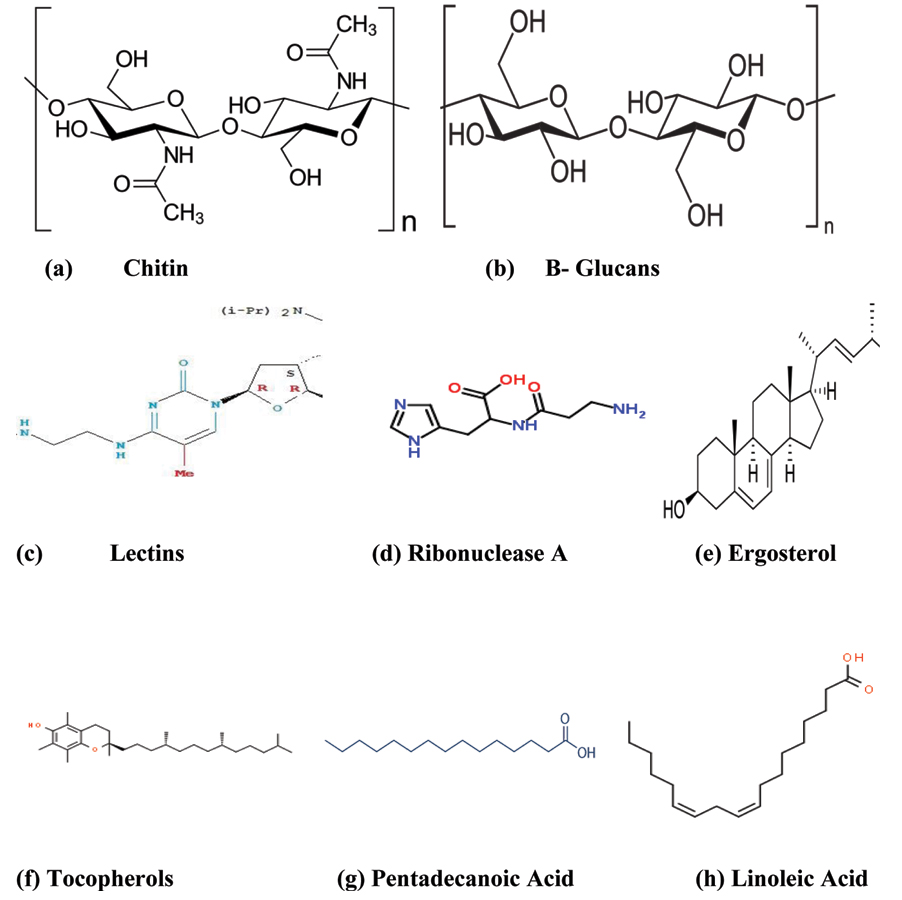
4. Minerals
The macrominerals present generally in mushrooms are phosphorus, sodium, and potassium whereas trace elements such as iron and zinc are also present. The fruiting body of mushroom consists of an elevated level of assimilable mineral constituents. According to the data obtained from previous studies, mushrooms of the genus Pleurotus can be a useful source of phosphorus, potassium, iron, zinc, calcium, magnesium, manganese, and copper [4]. Therefore, mushrooms should be included as a part of our diet to combat deficiencies of trace elements such as iron, zinc, and other micronutrient deficiencies. The mineral content among the individual mushrooms varies from species to species. This variation may be due to differences in nutrient sources used for cultivation and also due to varied protocols applied for mineral determination [30].
Limitation(s)
There may be a high level of clinical heterogeneity due to the varied investigations included in different study designs. The review was based on full length articles and communications reported only in English dialect, so the review might be subjected to language bias. However, the data obtained via the secondary sources are stored in a password protected system as per GDPR, 2018 guideline [63].
Conclusion(s)
Mushrooms have been considered as an important part of our daily diet since ancient times due to its immense nutritional values. Moreover, by definition, mushrooms justify the role of nutraceuticals, i.e., food having medicinal benefits. As evident from varied past scientific confirmations, mushrooms contain many complex polysaccharides, enriched with proteins that are responsible for different categories of medicinal properties. The mushrooms which are edible in nature are usually low in fat contents and among them few are essential ones. Moreover, mushrooms are also rich in macro-minerals and therefore their inclusion within our diet can help us to combat against varied nutritional deficiencies. Thus mushrooms are considered to be a repertoire of varied significant dietary composition that contributes to a healthy diet and their daily consumption is expected to boost up our health against many diseases.